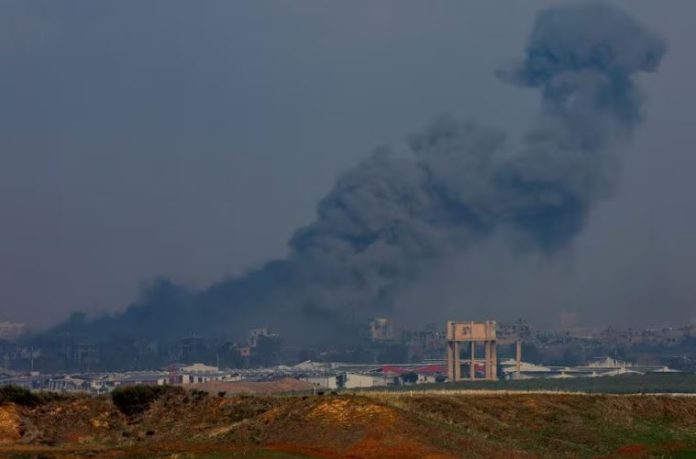
—— Lack of food, clean water, shelter have worn down hundreds of thousands of traumatised people, says aid workers
—— Israel’s relentless bombing grows desperation, hunger in Gaza
—— UN says food trucks being intercepted, stopped
—— Palestinian death toll reaches 18,787, including about 8000 children
DM Monitoring
GAZA: For the besieged residents of Gaza who have so far survived Israel’s bombs and bullets, a silent, invisible killer is now stalking them: disease.
A lack of food, clean water and shelter have worn down hundreds of thousands of traumatised people and, with a health system on its knees, it’s inevitable epidemics will rip through the enclave, 10 doctors and aid workers told Reuters. “The perfect storm for disease has begun. Now it’s about, ‘How bad will it get?’” James Elder, chief spokesperson for the UN children’s fund (UNICEF), said in an interview.
From November 29 to December 10, cases of diarrhoea in children under five jumped 66% to 59,895 cases, and climbed 55% for the rest of the population in the same period, according to data from the World Health Organization (WHO). The UN agency said the numbers were inevitably incomplete due to the meltdown of all systems and services in Gaza because of the war. The head of the paediatric ward at Nasser Hospital in Khan Younis in southern Gaza, Dr. Ahmed Al-Farra, told Reuters on Tuesday his ward was overrun with children suffering extreme dehydration, causing kidney failure in some cases, while severe diarrhoea was four times higher than normal.
He said he was aware of 15 to 30 cases of Hepatitis A in Khan Younis in the past two weeks: “The incubation period of the virus is three weeks to a month, so after a month there will be an explosion in the number of cases of Hepatitis A.” Since the truce between Israel and Hamas collapsed on December 1, hundreds of thousands of people have moved to makeshift shelters – abandoned buildings, schools and tents.
Many others are sleeping in the open with little access to toilets or water to bathe, aid workers said. At the same time, 21 of the Gaza Strip’s 36 hospitals are closed, 11 are partially functional and four are minimally functional, according to WHO figures from December 10. Marie-Aure Perreaut, emergency medical coordinator for MSF’s operations in Gaza, said the medical charity had left a health centre in Khan Younis 10 days ago – because the area was within Israel’s evacuation orders – where it had been treating respiratory tract infections, diarrhoea and skin infections,
She said two things were now inevitable.
“The first is an epidemic of something like dysentery will spread across Gaza, if we continue at this pace of cases, and the other certainty is that neither the ministry of health nor the humanitarian organisations will be able to support the response to those epidemics,” she said.
‘Practice of medicine is under attack’
Academic researchers at the London School of Hygiene & Tropical Medicine warned in a November 6 report – a month after the Hamas attack on Israel triggered the Gaza war – of how the indirect health effects of the conflict would worsen over time.
They said that two months into the war there would be an increased burden of infant malnutrition due to disrupted feeding and care, and the nutrition of mothers would worsen. “With time, increasing chance of introduction of epidemic-prone pathogens. Risk factors: overcrowding, inadequate (water and sanitation).”
Aid workers say what the experts in London predicted is exactly what’s playing out now. Three experts said diseases such as dysentery and watery diarrhoea could end up killing as many children as Israeli bombardments have done so far. The U.N. aid agency for Palestinian refugees (UNRWA) said two months of brutal war combined with a “very tight siege” have forced 1.3 million Gazans out of a population of 2.3 million to seek safety at its sites in the strip of land by the Mediterranean Sea.
“Many of the shelters are overwhelmed with people seeking safety, with four or five times their capacity,” said Juliette Touma, UNRWA’s director of communications. “Most of the shelters are not equipped with toilets or showers or clean water.”
Since the war started, 135 staff of UNRWA have been killed and 70% of staff have fled their homes, two of the reasons why UNRWA is now operating only nine of the 28 primary health clinics it had prior to the war, Touma said.
All told, at least 364 attacks on healthcare services have been recorded in Gaza since October. 7, UN special rapporteur on the right to health, Tlaleng Mofokeng, said in December 7 statement.
“The practice of medicine is under attack,” she said.
More than 300 Gazan health ministry staff and medics have been killed since October 7, the ministry said on Wednesday.
Salim Namour, a Syrian surgeon who treated the sick and wounded in eastern Ghouta outside Damascus during a years-long siege imposed by the Syrian government, said the images from Gaza reminded him of the scenes he experienced first-hand.
He said hepatitis and tuberculosis spread in Ghouta as its sewage system was destroyed and water contaminated. Malnutrition weakened people’s immunity and – setting aside wounds caused by shelling – shortages of antibiotics and vaccines for children encouraged the spread of disease.
“Siege … is a way to cause society to collapse. It means hunger, it means shortages of medical supplies, no electricity, no refrigeration, no way to preserve medicines or food, no heating,” said Namour, who left Ghouta in 2018 and lives in Germany.
Gaza’s health ministry said on Wednesday its supplies of childhood vaccines had run out. Overnight on Wednesday, strong winds and heavy rain ripped the flimsy tents at a camp in Rafah and flooded the ground, forcing people to spend the night huddled in the cold on wet sand.
The United Nations is tracking the incidence of 14 diseases with “epidemic potential” and is most concerned about soaring rates of dysentery, watery diarrhoea, and acute respiratory infections, according to a list the UN is currently using for Gaza seen by Reuters on Tuesday.
Dr. Paul Spiegel, director of the Center for Humanitarian Health at the John Hopkins Bloomberg School of Public Health, who is in Cairo working on the UN response, said a diarrhoea outbreak could happen as soon as tomorrow, unless many more aid trucks were let in and clean water was provided.
He also said the UN plans to start documenting the levels of acute malnutrition among children in Gaza soon by measuring their mid-upper arm circumference, known as a MUAC test.
“When you have acute malnutrition, which is called wasting, people, they die from that, but then they are also so much more vulnerable to other diseases,” said Spiegel.



